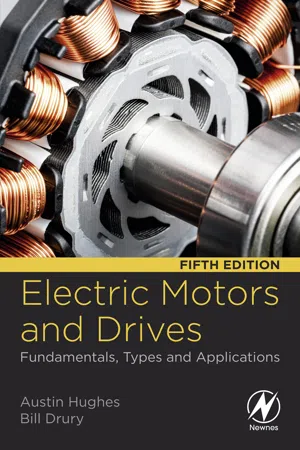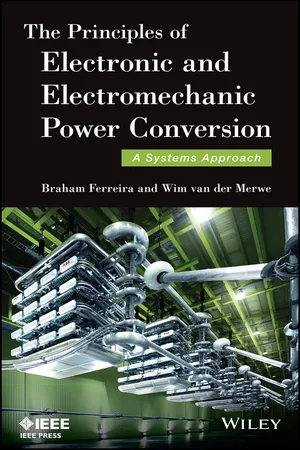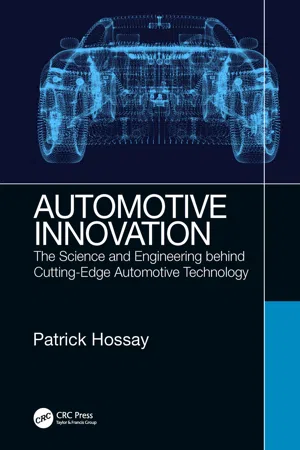Physics
Linear Motor
A linear motor is a type of electric motor that produces motion in a straight line, as opposed to the rotational motion produced by traditional motors. It consists of a moving part (the "slider") and a stationary part (the "stator") that generates a magnetic field to propel the slider. Linear motors are used in various applications, including transportation systems, industrial automation, and robotics.
Written by Perlego with AI-assistance
Related key terms
Related key terms
1 of 4
Related key terms
1 of 3
4 Key excerpts on "Linear Motor"
- eBook - ePub
Electric Motors and Drives
Fundamentals, Types and Applications
- Austin Hughes, Bill Drury(Authors)
- 2019(Publication Date)
- Newnes(Publisher)
P = Tω . We will now see that the presence of relative motion between the conductors and the field always brings ‘motional e.m.f.’ into play; and we will find that this motional e.m.f. plays a key role in quantifying the energy conversion process.1.6.1 Elementary motor—Stationary conditions
The primitive linear machine is shown pictorially in Fig. 1.14 and in diagrammatic form in Fig. 1.15 . It consists of a conductor of active1 length l which can move horizontally perpendicular to a magnetic flux density B .Fig. 1.14 Primitive linear d.c. motor.Fig. 1.15 Diagrammatic sketch of primitive linear d.c. motor.It is assumed that the conductor has a resistance (R ), that it carries a d.c. current (I ), and that it moves with a velocity (v ) in a direction perpendicular to the field and the current (see Fig. 1.15 ). Attached to the conductor is a string which passes over a pulley and supports a weight: the tension in the string acting as a mechanical ‘load’ on the rod. Friction is assumed to be zero.We need not worry about the many difficult practicalities of making such a machine, not least how we might manage to maintain electrical connections to a moving conductor. The important point is that although this is a hypothetical set-up, it represents what happens in a real motor, and it allows us to gain a clear understanding of how real machines behave before we come to grips with more complex structures.We begin by considering the electrical input power with the conductor stationary (i.e. v = 0). For the purpose of this discussion we can suppose that the magnetic field (B - eBook - ePub
The Principles of Electronic and Electromechanic Power Conversion
A Systems Approach
- Braham Ferreira, Wim van der Merwe(Authors)
- 2013(Publication Date)
- Wiley-IEEE Press(Publisher)
Fig. 7.7 , the magnetic field is pointing directly into the page, whereas the track is running along the page to the right.Figure 7.7A linear dc machine.We will make one further assumption. Let us assume that the magnetic field caused by the current in the conductors, especially in the rails and the conducting bar, is much smaller than the external magnetic field.We can discuss the behaviour of our machine by investigating four different equations that stand central to the machine operation.1. The force in the conducting bar due to the current in the presence of the magnetic field. Recall that the force is calculated asBy application of the right-hand rule, we see that with respect to the system shown in Fig. 7.7 , the induced force will be towards the right if the current is flowing downwards and towards the left if it flows upwards. As the current and the magnetic field are perpendicular to each other, we can write7.9where the directions of and are shown in Fig. 7.7 .2. The voltage induced by a conductor moving in a magnetic field is defined asOnce again, the direction of movement and the magnetic field are perpendicular to each other, and therefore, the induced voltage can be written as7.10with the direction of as indicated in Fig. 7.7 . You can verify this statement with the right-hand rule.3. Newton's second law of motion states that7.11where is the mass and is the linear acceleration. This law describes the motion of the conducting bar, with the linear acceleration along the tracks and - eBook - ePub
Electric Machines and Drives
Principles, Control, Modeling, and Simulation
- Shaahin Filizadeh(Author)
- 2013(Publication Date)
- CRC Press(Publisher)
1Physics of Electric Machines
1.1 Introduction
Electric machines are devices used for energy conversion, mostly between mechanical and electrical forms. An electric motor is a machine that converts the electrical energy given to it as input to mechanical energy output; a generator does the reverse by producing electrical energy from mechanical energy input. Study of electric machines, therefore, requires knowledge and understanding of the principles of energy conversion.Electric machines come in a wide variety of forms and sizes and are used in markedly different ways and applications. Consider, on the one hand, a small electric motor that rotates and precisely positions a compact disk in a CD drive and, on the other hand, a massive generator in a power plant that is driven by a turbine and generates large amounts of electricity. Despite such apparent differences in scale and application, all electric machines operate on the same underlying principles and share a simple backbone, which is a magnetic medium that links the electrical and mechanical ends of a machine.Apart from its function of facilitating generation and directing magnetic flux to link machine windings, an electromagnetic medium also enables and facilitates the conversion and flow of energy between the two ends of a rotating electric machine, that is, its electrical and mechanical ends. Proper study of a rotating electric machine will therefore entail consideration of its magnetic structure and its role in the process of energy conversion. Although the study of electromagnetic systems is often associated with vector calculus of Maxwell’s equations, it is indeed possible to describe and understand the behavior of electric machines in simple terms without recourse to complicated mathematics.The intention of this chapter is to establish a foundation for understanding the operation of rotating electric machines using simple laws of physics. We use mathematics only as a facilitator and avoid it if the phenomenon at hand can be described equally well using words, figures, and qualitative description and judgment. Modeling and detailed analysis of electric machines requires mathematics, which is presented later (see Chapters 3 and 4 - eBook - ePub
Automotive Innovation
The Science and Engineering behind Cutting-Edge Automotive Technology
- Patrick Hossay(Author)
- 2019(Publication Date)
- CRC Press(Publisher)
power electronics (the combined electronic, electromagnetic, and electrochemical components that control and convert power) have fundamentally reshaped what is viable in electric motors and thus what is achievable in EVs and HEVs. As a result, ideas and concepts that have been known for many decades as conceptually possible but not feasible, have now become technically practicable options.The Principles of the Electric Motor
As always, let’s start at the beginning. Motors function by exploiting electromagnetic force, one of the four fundamental forces of nature. As might be obvious from the name, electromagnetism defines a relationship between magnetism and electricity. In fact, magnetic and electric forces are really fundamentally the same sort of thing; both are defined by the exchange of photons between charged particles, called an exchange force . In our case, the particles are electrons. You can think of photons as elementary particles or waves that act as force carriers , traveling between electrons and exerting force, and defining both electric and magnetic fields.Of course, to understand magnetic fields we need to understand magnets. Three elements, iron, nickel, and cobalt, demonstrate the property of ferromagnetism , or the ability to be permanently magnetized when placed in a magnetic field. This magnetization happens at the atomic level. The atoms that compose these materials are themselves like tiny magnets with opposing poles, or magnetic moments , that produce a magnetic field, interact with other magnetic moments and change their orientation in response to magnetic fields. When these atoms are similarly oriented throughout the material, their fields combine together and define a uniform magnetic domain. So, by exposing a ferromagnetic material to a powerful magnetic field, the orientation of these crystals can be aligned so that all the magnetic axes point in the same direction, thus creating a magnet. Importantly, with these three materials, when the magnetic field is removed the polarization remains, defining a permanent magnet (PM). When certain rare earth elements, in particular neodymium and samarium–cobalt, are combined with these elements, they can form magnets that are several orders of magnitude more powerful than the simple ferrite magnets on your refrigerator. In addition, as we will see later, some metals, such as copper and aluminum, do not become PMs themselves, but can exhibit magnetic qualities when an electric current is passed through them. This allows us to define controllable magnets that can be switched on and off, called electromagnets
Index pages curate the most relevant extracts from our library of academic textbooks. They’ve been created using an in-house natural language model (NLM), each adding context and meaning to key research topics.
Explore more topic indexes
Explore more topic indexes
1 of 6
Explore more topic indexes
1 of 4



